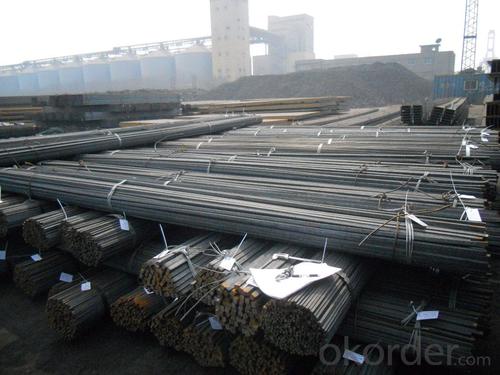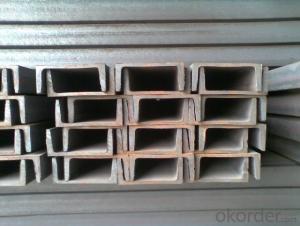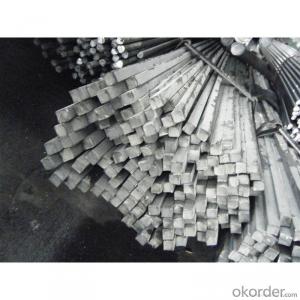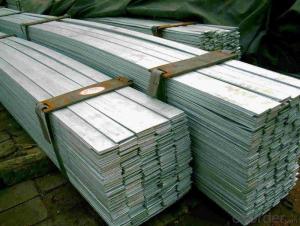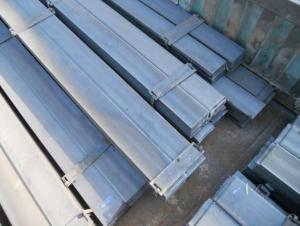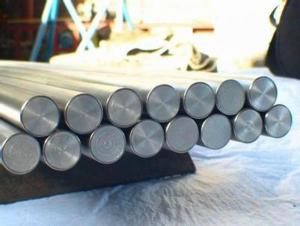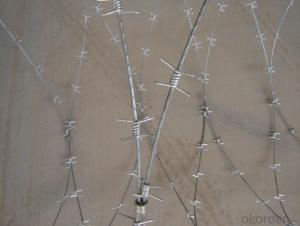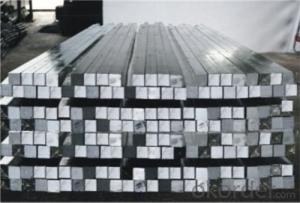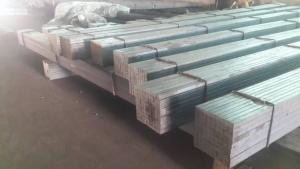Steel Square Bar with High Quality
- Loading Port:
- China Main Port
- Payment Terms:
- TT or LC
- Min Order Qty:
- -
- Supply Capability:
- -
OKorder Service Pledge
OKorder Financial Service
You Might Also Like
OKorder is offering Steel Square Bar with High Quality at great prices with worldwide shipping. Our supplier is a world-class manufacturer of steel, with our products utilized the world over. OKorder annually supplies products to European, North American and Asian markets. We provide quotations within 24 hours of receiving an inquiry and guarantee competitive prices.
The allowed tolerance of Square Steel:
Length of a side(mm) | Allowed Tolerance | ||
Group1 | Group2 | Group3 | |
5.5~7 | ±0.20 | ±0.30 | ±0.40 |
7~20 | ±0.25 | ±0.35 | ±0.40 |
20~30 | ±0.30 | ±0.40 | ±0.50 |
30~50 | ±0.40 | ±0.50 | ±0.60 |
60~80 | ±0.60 | ±0.70 | ±0.80 |
80~110 | ±0.90 | ±1.0 | ±1.1 |
110~150 | ±1.2 | ±1.3 | ±1.1 |
150~190 | ―― | ―― | ±2.0 |
190~250 | ―― | ―― | ±2.5 |
Chemical Composition:
Standard | Grade | Element (%) | ||||
GB | Q195 | C | Mn | S | P | Si |
≤0.12 | ≤0.50 | ≤0.04 | ≤0.035 | ≤0.3 | ||
-Method of deoxidation: F, b, Z
Packaging & Delivery of Square Steel:
-Packing Detail: The products can be packed in bundles by steel wires.
-Delivery Detail: 30~45 working days after receive buyer’s T.T. or L/C.
Transportation & Marking:
-Transportation:
1, The products can be delivered by bulk vessel or by container.
2, The maximum quantity of loading of container is 25 tons.
3, The products usually are transported to the nearest port from the production place.
-Marks:
1, Color mark: there will be color marking on both ends of the bundles for the cargo delivered by bulk vessel. That makes is easily to distinguish at the destination port.
2, Tag mark: the tag marks will be tied up to each bundle. The information is usually including supplier’s logo and name, product name, made in China, products’ specifications and other information requested by customers.
Product Applications:
Steel Square Bar with High Quality are ideal for structural applications and are widely used in the construction of buildings and bridges, and the manufacturing, petrochemical, and transportation industries.
Product Advantages:
OKorder's Steel Square Bar with High Quality Bar are durable, strong, and resist corrosion.
Main Product Features:
· Premium quality
· Prompt delivery & seaworthy packing (30 days after receiving deposit)
· Corrosion resistance
· Can be recycled and reused
· Mill test certification
· Professional Service
· Competitive pricing
Product Specifications:
Standard: GB
Material: Q235
Origin place: China
Thickness: 3mm-30mm
Width:20mm-200mm
Length: Max 12m
FAQ:
Q1: Why buy Materials & Equipment from OKorder.com?
A1: All products offered byOKorder.com are carefully selected from China's most reliable manufacturing enterprises. Through its ISO certifications, OKorder.com adheres to the highest standards and a commitment to supply chain safety and customer satisfaction.
Q2: How do we guarantee the quality of our products?
A2: We have established an advanced quality management system which conducts strict quality tests at every step, from raw materials to the final product. At the same time, we provide extensive follow-up service assurances as required.
Q3: What makes stainless steel stainless?
A3: Stainless steel must contain at least 10.5 % chromium. It is this element that reacts with the oxygen in the air to form a complex chrome-oxide surface layer that is invisible but strong enough to prevent further oxygen from "staining" (rusting) the surface. Higher levels of chromium and the addition of other alloying elements such as nickel and molybdenum enhance this surface layer and improve the corrosion resistance of the stainless material.
Images:
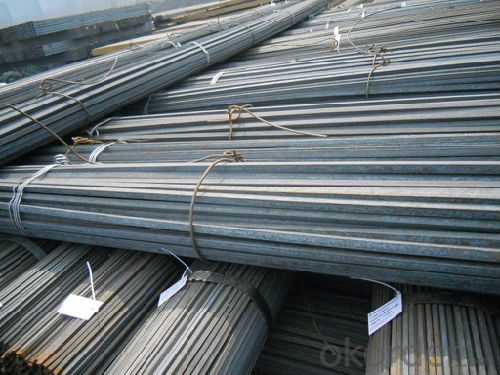

- Q: How do you use a steel square to scribe a line?
- To use a steel square to scribe a line, align one edge of the square with the material's edge and hold it firmly in place. Then, using a sharp pencil or scribe, trace along the other edge of the square to create a straight and accurate line.
- Q: How do you use a steel square for marking and cutting angled mortise and tenon joints?
- In order to mark and cut angled mortise and tenon joints using a steel square, it is necessary to follow a series of steps: 1. Begin by determining the desired angle for the joint. This can be accomplished by utilizing a protractor or referencing a specific angle measurement. 2. Once the angle has been established, position the steel square along the edge of the wood to be cut. Ensure that the long side of the square aligns with the wood's edge. 3. Employ a pencil or marking knife to indicate the desired length of the tenon on the wood's face. This will serve as the portion that fits into the mortise. 4. Next, employ the short side of the steel square to mark the shoulder line of the tenon on both the face and edge of the wood. The shoulder line denotes the point of contact between the tenon and the mortise, creating a clean and flush joint. 5. Subsequently, using the same angle, transfer the marks onto the wood piece that will contain the mortise. Ensure that the marks align with those made on the tenon piece. 6. Utilize a chisel or mortising machine to remove the excess material within the marked shoulder lines on the wood piece with the mortise. Take care and proceed meticulously to achieve precise and clean material removal. 7. Finally, employ a saw or chisel to cut along the marked tenon lines on the tenon piece, eliminating the surplus material and shaping the tenon to fit snugly into the mortise. Always remember to measure twice and cut once to guarantee accuracy.
- Q: How do you use a steel square to determine the angle of a cove cut?
- To use a steel square to determine the angle of a cove cut, follow these steps: 1. Start by placing the steel square on the surface where you plan to make the cove cut. Ensure that one side of the square is aligned with the edge of the material. 2. Align the other side of the square with the desired angle of the cove cut. The angle should be set according to the design or specifications you are working with. 3. Once the square is properly aligned, use a pencil or marking tool to mark the angle on the surface of the material. 4. Next, use a suitable cutting tool such as a jigsaw, bandsaw, or router to cut along the marked angle. Ensure that you have appropriate safety measures in place and follow the manufacturer's instructions for your specific cutting tool. 5. Make the cut slowly and carefully, following the marked angle as closely as possible. Take your time to achieve a precise and accurate cove cut. Remember to always practice caution and wear appropriate safety gear when operating power tools or cutting materials. Additionally, it is recommended to double-check your measurements and angle before making the cut to ensure accuracy and desired results.
- Q: Can a steel square be used for cabinet hardware installation?
- No, a steel square is not typically used for cabinet hardware installation. Cabinet hardware installation usually requires specific tools such as drills, screwdrivers, and measuring tapes.
- Q: How do you use a steel square to mark out mortise and tenon joints?
- To use a steel square to mark out mortise and tenon joints, you would start by aligning one leg of the square against the edge of the timber. Then, you would use the other leg of the square to mark the width of the tenon on the end of the timber. Next, you would use the square to mark the depth of the mortise on the side of the timber, ensuring it aligns with the tenon. Repeat this process on the corresponding piece of wood to ensure accurate and matching joints.
- Q: Can a steel square be used for checking the squareness of a picture frame miter joint?
- No, a steel square cannot be used for checking the squareness of a picture frame miter joint. A miter joint requires a specialized tool such as a miter square or a miter gauge to accurately check and ensure the squareness of the joint.
- Q: Can a steel square be used for checking the alignment of a table saw fence?
- Yes, a steel square can be used for checking the alignment of a table saw fence. The straight edges of a steel square can be placed against the table saw fence and the table surface to ensure that they are parallel.
- Q: Can a steel square be used for measuring lengths as well?
- No, a steel square cannot be used for measuring lengths. A steel square, also known as a framing square or carpenter's square, is primarily used in carpentry and woodworking for measuring and marking angles, not for measuring lengths. It has a right angle shape with a long arm and a shorter perpendicular arm, which are used to check and mark 90-degree angles. To measure lengths accurately, a measuring tape or a ruler would be more appropriate.
- Q: Can a steel square be used for measuring the width of a door frame?
- Yes, a steel square can be used for measuring the width of a door frame.
- Q: Can a steel square be used for gazebo post layout and installation?
- Indeed, gazebo post layout and installation can benefit greatly from the utilization of a steel square. A steel square, commonly referred to as a framing square or carpenter's square, is a versatile tool frequently employed in the domains of construction and woodworking. Comprised of a lengthy blade and a shorter tongue that intersect at a 90-degree angle, this tool enables precise measurements and layout. When it comes to gazebo post layout and installation, the value of a steel square cannot be overstated. It facilitates the determination of accurate angles and measurements required for the positioning of the posts, ensuring their proper alignment and levelness. To employ a steel square for gazebo post layout, one can utilize it to mark the corners and angles where the posts ought to be placed. By aligning either the blade or the tongue of the square with the edges of the gazebo base or the desired location of the posts, one can guarantee precise measurements and angles. Additionally, during the installation process, a steel square proves to be quite useful for verifying the plumbness and levelness of the posts. By positioning the square against the sides of the posts, one can ascertain whether they are perfectly vertical or if adjustments need to be made. In conclusion, a steel square is undeniably suitable for gazebo post layout and installation. Its versatility and accuracy render it an invaluable tool for ensuring the accurate positioning and levelness of the posts.
Send your message to us
Steel Square Bar with High Quality
- Loading Port:
- China Main Port
- Payment Terms:
- TT or LC
- Min Order Qty:
- -
- Supply Capability:
- -
OKorder Service Pledge
OKorder Financial Service
Similar products
Hot products
Hot Searches
Related keywords



